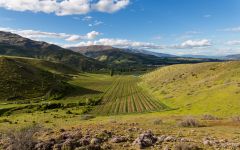Mt Difficulty Long Gully Pinot Noir 2013
-
Wine
Enthusiast



Product Details
Your Rating
Somm Note
Winemaker Notes
Professional Ratings
-
Wine Enthusiast
This is a sturdy, tannic wine, but one that should come around in a few years. Vanilla, cedar and dark fruit notes have the spotlight for now, with hints of mocha coming on strong on the long finish.
Cellar Selection






Established in 1992, and located at the base of the mountain for which it is named, Mt Difficulty is Central Otago’s leading artisan winegrower with a pioneering heritage in the Bannockburn sub-region. Mt Difficulty was among the first to plant vineyards on the south bank of the Kawarau River, and today its terroir-driven wines are among the most famous New Zealand Pinot Noirs in the world. By stressing ethical viticulture and minimal intervention, Mt Difficulty produces wines that express their personality and reflect their unique home.
The southern end of the South Island is a rugged landscape with climate extremes found nowhere else in New Zealand. The unique microclimate of the Bannockburn area is influenced by the presence of Mount Difficulty which is integral in providing low rainfall and humidity for the region. Bannockburn enjoys hot summers, a large diurnal temperature variation and long cool autumns; conditions which bring the best out of the Pinot Noir grapes. Equally important are the high pH soils that are a mix of clay and gravels: grapes produce their best wines on sweet soils.
Mt Difficulty’s second label, Roaring Meg, celebrates Central Otago’s storied history. According to local legend, the original Meg was a spirited and enterprising redhead who accompanied the miners during the region’s gold rush of the 1860’s. Bold, vivacious, and unforgettable, Roaring Meg’s memory lives on in these stylish, fruit-driven wines. Produced with Pinot Noir sourced exclusively from vineyards in Bannockburn and the Cromwell Basin, the early-drinking style of Roaring Meg wines struck a chord with the public when it was introduced in 2001, and the label has been a mainstay at Mt Difficulty ever since.

Thin-skinned, finicky and temperamental, Pinot Noir is also one of the most rewarding grapes to grow and remains a labor of love for some of the greatest vignerons in Burgundy. Fairly adaptable but highly reflective of the environment in which it is grown, Pinot Noir prefers a cool climate and requires low yields to achieve high quality. Outside of France, outstanding examples come from in Oregon, California and throughout specific locations in wine-producing world. Somm Secret—André Tchelistcheff, California’s most influential post-Prohibition winemaker decidedly stayed away from the grape, claiming “God made Cabernet. The Devil made Pinot Noir.”

Historically and presently the most important wine-producing region of Australia, the Barossa Valley is set in the Barossa zone of South Australia, where more than half of the country’s wine is made. Because the climate is very hot and dry, vineyard managers work diligently to ensure grapes reach the perfect levels of phenolic ripeness.
The intense heat is ideal for plush, bold reds, particularly Shiraz on its own or Rhône Blends. Often Shiraz and Cabernet partner up for plump and powerful reds.
While much less prevalent, light-skinned varieties such as Riesling, Viognier or Semillon produce vibrant Barossa Valley whites.
Most of Australia’s largest wine producers are based here and Shiraz plantings date back as far as the 1850s or before. Many of them are dry farmed and bush trained, still offering less than one ton per acre of inky, intense, purple juice.
